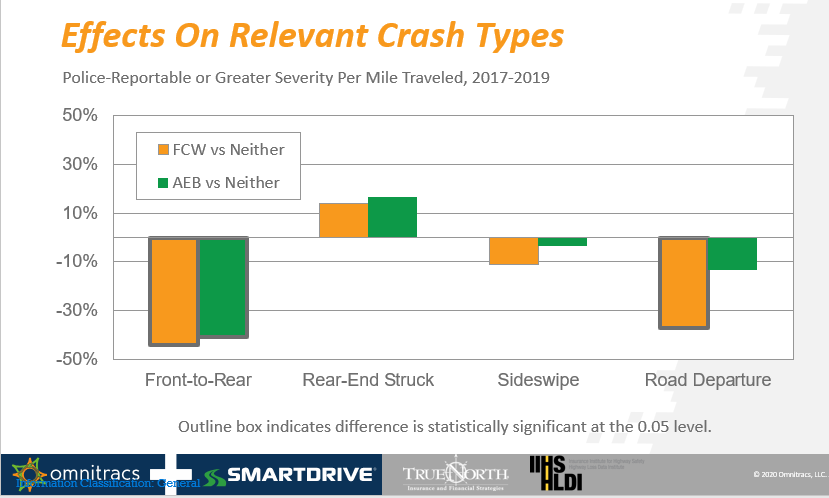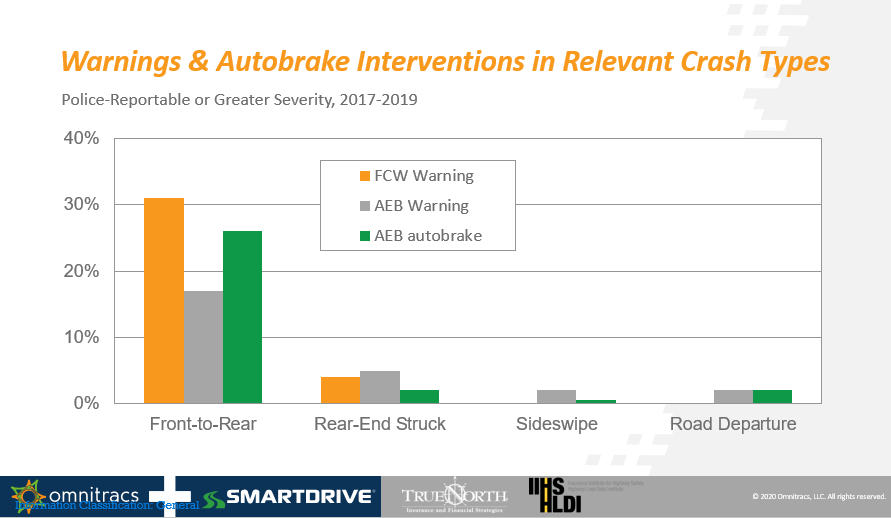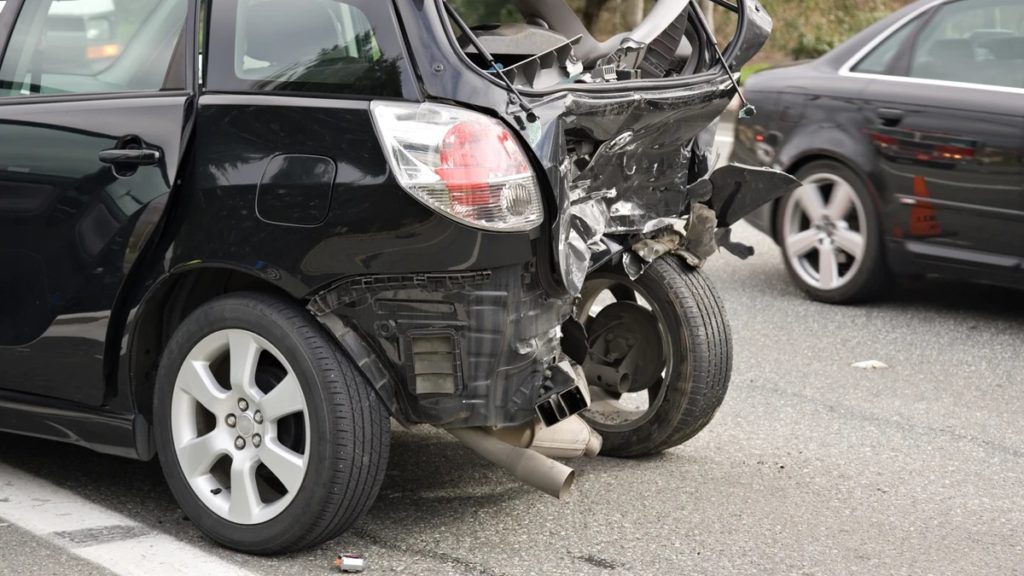Based on Class 8 truck driving data from SmartDrive, an insurance group finds that forward-collision warning and automatic emergency braking systems make highways safer.
Installing forward-collision warning and automatic emergency braking systems on heavy-duty vehicles could eliminate more than 40% of rear-end crashes involving large trucks, according to an Insurance Institute for Highway Safety (IIHS) study of SmartDrive Systems data.
The study results were presented by Eric Teoh, the director of statistical services for IIHS, during an Oct. 20 FleetOwner webinar on advanced driving systems for large trucks, which are starting to become more prevalent in the industry. Teoh studied crash data from 62 commercial fleets operating tractor-trailers and trucks weighing at least 33,000 lbs. The study found that trucks with front-crash prevention systems such as forward-collision warning (FCW) had 22% fewer crashes and trucks with automatic emergency braking (AEB) had 12% fewer collisions.
While the European Union started requiring AEB and FCW on most heavy-duty trucks in 2013, it is not required on any vehicle in the U.S. However, it is expected to become the norm for passenger vehicles this decade, Teoh said. The 20 automakers that produce 99% of the new passenger vehicles here agreed to make AEB standard by September 2022 based on a voluntary commitment brokered by IIHS and the National Highway Safety Administration.
Front crash prevention systems use cameras, radar or other sensors to monitor the roadway ahead. Some include only forward collision warning, which alerts the driver to obstacles in the roadway. AEB systems go further — automatically applying the brakes to prevent the collision or reduce its severity.
 Chart: Omnitracs
Chart: Omnitracs
“In terms of trucking, we know many of the larger fleets have been buying these technologies and have had a pretty good experience with them,” Teoh said. But he noted that there have been more studies on the effectiveness of the systems on passenger vehicles, which have shown the benefits of the technologies:
- FCW reduces the front-to-rear crash rate by 27% for passenger vehicles
- AEB reduces the front-to-rear crash rate by 50% for passenger vehicles
- This has also reduced collision and injury insurance claim rates
“But we know a little bit less about the systems’ effectiveness on large trucks,” Teoh said. “We do know that they’re relevant to a very large number of crashes — about 20,000 to 30,000 — a year. And there have been studies looking at in-depth data that, under various assumptions, kind of said that if the truck had this technology, we think it would have helped or we don’t think it would have helped.”
Based on those assumptions, Teoh said that FCW and AEB would have reduced rear-end collisions involving large trucks by 22% to 24%. But to get a better feel for actual numbers, IIHS partnered with SmartDrive, the video-based safety telematics company recently acquired by Omnitracs.

Chart: Omnitracs
Teoh’s study of SmartDrive date included about 2,000 crashes that occurred over more than 2 billion vehicle miles traveled by about 25,000 Class 8 trucks from 2017-19. The study compared trucks from the same carriers equipped with FCW alone, AEB, and no front crash prevention. AEB systems generally include forward-collision warning too. The study only included incidents on limited-access highways — so no intersection crashes or pedestrian incidents were included.
A benefit of getting the data from SmartDrive — instead of through the 62 individual carriers — was all collected the same way and anonymized, Teoh said. “It’s a nice, broad sample,” he said. The study was also able to compare trucks with different technologies within the same carrier. “That way, we don’t have any carrier-to-carrier differences that were accidentally attributed to the technology.”
The study showed that AEB and FCW are likely to have benefits beyond the reduction in crashes. For example, Teoh noted, some crashes that aren’t prevented by the systems are made less severe, thanks to a decrease in impact speed. This is true whether it’s the automated system applying the brakes or a human driver who has more time to react because of a warning, he said.
Both FCW and AEB associated with substantial reductions in crash rates, Teoh reported. The technologies reduced front-to-rear crashes by more than 40%. And while he noted the systems are “not a silver bullet, they are effective countermeasures.” An added benefit is even if a crash can’t be prevented, the systems can reduce the severity of rear-end crashes involving Class 8 trucks.
By Josh Fisher
Source: https://www.fleetowner.com
CUT COTS OF THE FLEET WITH OUR AUDIT PROGRAM
The audit is a key tool to know the overall status and provide the analysis, the assessment, the advice, the suggestions and the actions to take in order to cut costs and increase the efficiency and efficacy of the fleet. We propose the following fleet management audit.




